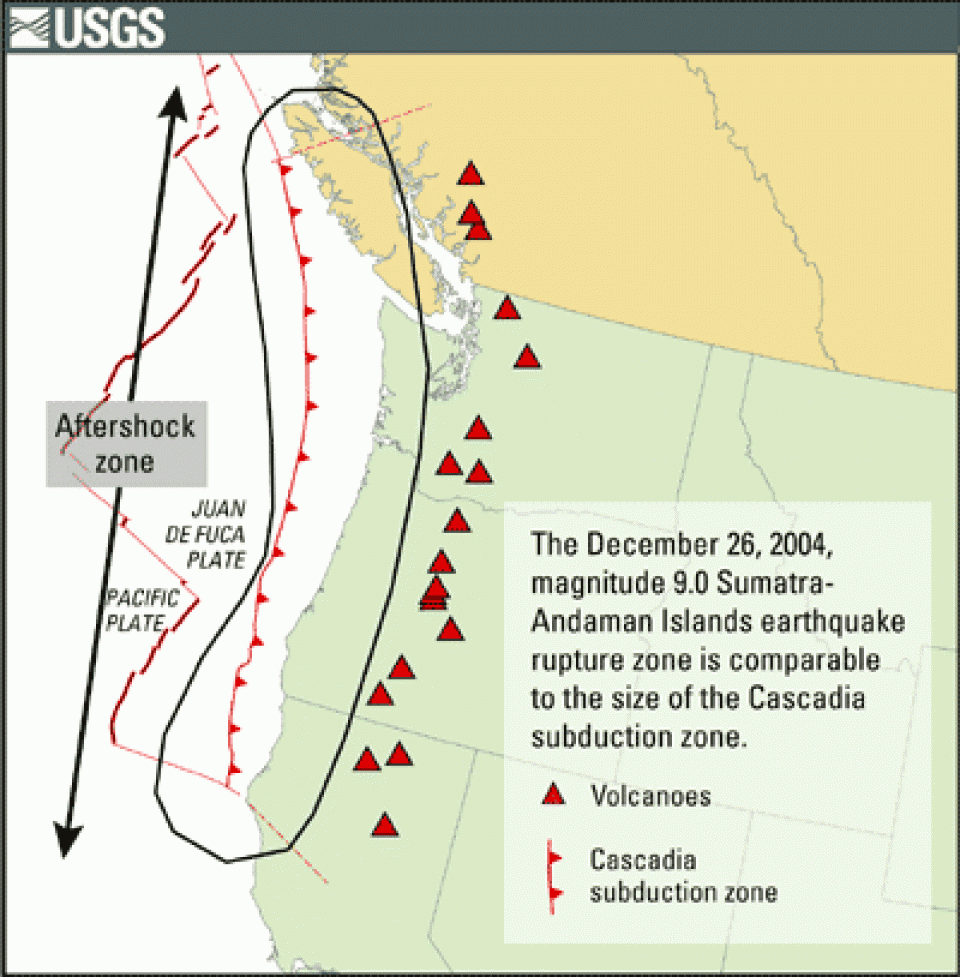
© American Geoscience InstituteScreenshot of a graphic showing the Cascadia Subduction Zone.
Red cedar "ghost forests," a Japanese villager's handwritten notes, and Native American oral histories:
They all offered clues that led scientists to precisely date the last megaquake that rocked the Pacific Northwest.It occurred on Jan. 26, 1700.Unraveling the clues was similar to being a detective investigating a "not-so-ancient geological crime," U.S. Geological Survey scientist Brian Atwater said during a presentation to a full house at LCC's Health and Science lecture hall Wednesday night.
But "there's an edge to this story," he said. "It's a frightening thing. ... The effects of the tsunami are not so pretty."
That is because the next quake could come at any time, though they recur on average every 500 years or so. But the intervals are highly variable, and researchers estimate that there's a 10 percent chance the region will be hit with the next magnitude 8 or larger earthquake within the next 50 years.
Whenever it occurs, it will shake the ground for several minutes from Vancouver Island to Northern California and churn up tsunamis that swamp coastal communities. Thousands may die, and the region's highway and utility infrastructure and thousands of buildings will collapse, geologists say.
Atwater is a pioneer whose research helped determine that giant "subduction zone" earthquakes have occurred in the Pacific Northwest in the past and will do so again.
In the 1990s, work by Atwater and other scientists such as Kenji Satake and David Yamaguchi linked a tsunami that reached Japan to a 9.0 earthquake that struck the Northwest Coast in January 1700. It occurred in the Cascadia Subduction Zone, where two of the earth's crustal plates collide. When one plate lurches and sinks (subducts) past the other, it releases shock waves that shake the ground and churn up giant sea waves (tsunamis).
The quake caused tidal and intertidal marshes and forests to sink several feet, allowing mud and saltwater to invade. The intrusion killed trees, leaving "ghost forests" behind. By counting the annual tree rings of both the dead and new trees that grow in their place, scientists can create a record of inundation related to the earthquakes. There are some places in Washington where, at low tide, dead trees from roughly 400 AD can be found, Atwater said.
He cited work by David Yamaguchi, a University of Washington tree-ring analyst, who reported in 1997 that rings from a ghost forest near Copalis Beach, Wash., revealed that the trees' last growing season was 1699.
Native American oral traditions described what may have been the event, Atwater said, citing stories from Billy Balch, a leader of the Makah Tribe and Chief Louis Nookmis of the Huu-ay-aht.
Stories like that - both precise historical tellings and mythological renditions - gave credence to the finding that some kind of tsunami hit the region.
Then came the clincher. Atwater shared a journal entry from a resident of a small Japanese village, which described the surprise - and confusion - those on the Japanese coast experienced when a tsunami arrived without an earthquake. The so-called
"orphan tsunami" caught many off-guard when it struck on a day in late January 1700.Scientists now believe it was the Cascadia earthquake, nearly 5,000 miles away, that triggered those waves. The shock waves took about 10 hours to reach Japan. Atwater said those waves move about as fast as jetliners. Counting backwards, researches dated the Cascadia quake to Jan. 26.
"(The journal) is from a different culture," Atwater said, "But you have this human being asking, 'Where did this come from?'"
Reader Comments
R.C.